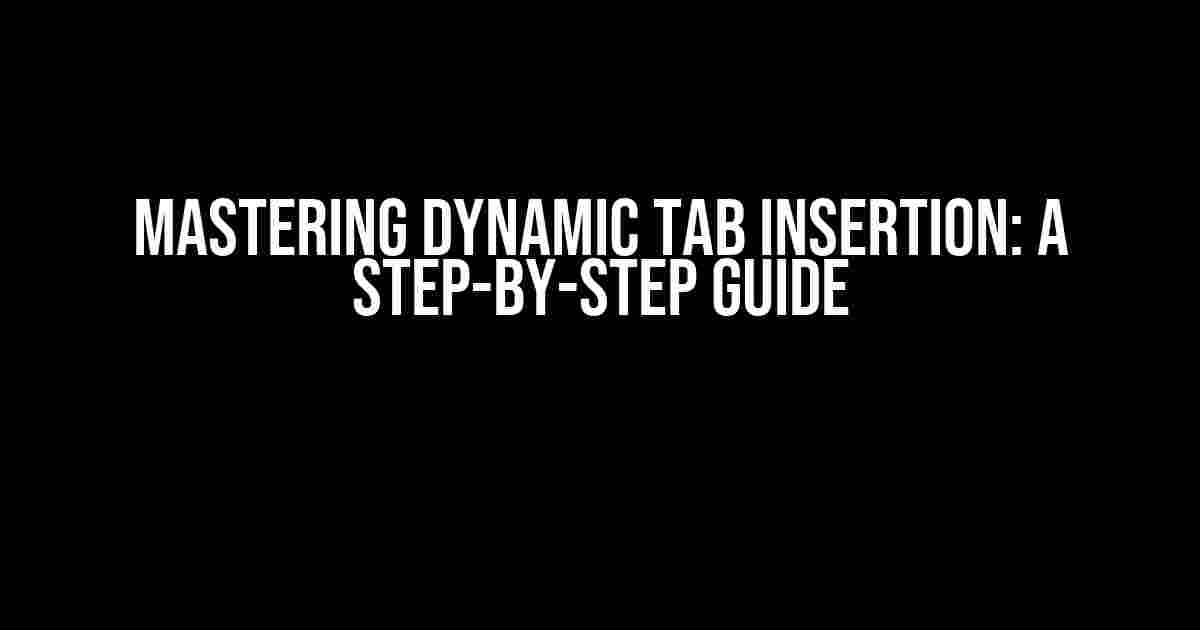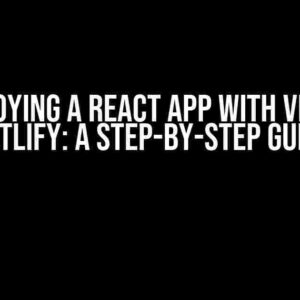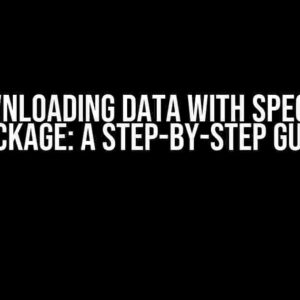Are you tired of manual tab management in your web application? Do you want to take your user experience to the next level? Look no further! In this comprehensive guide, we’ll show you how to dynamically insert new tabs with the press of an input task button. Buckle up, and let’s dive in!
What’s the Magic Behind Dynamic Tab Insertion?
Dynamic tab insertion is a powerful feature that allows users to create new tabs on the fly. This functionality is achieved by combining HTML, CSS, and JavaScript. We’ll break down the process into manageable chunks, so you can easily implement this feature in your own projects.
Why Dynamic Tab Insertion Matters
In today’s fast-paced digital landscape, users expect seamless interactions and instant results. Dynamic tab insertion provides a responsive and interactive experience, allowing users to manage their tabs efficiently. This feature is particularly useful in applications that require:
- Real-time data tracking and analysis
- Efficient task management and organization
- Personalized workflows and customization
Preparing the Groundwork: HTML Structure
Before we dive into the JavaScript magic, let’s set up our HTML structure. Create a basic HTML file and add the following code:
<div id="tab-container"> <ul id="tab-list"></ul> <div id="tab-content"></div> <input type="button" id="add-tab-btn" value="Add New Tab"> </div>
This code creates a container element for our tabs, a list element for our tab navigation, a content area for our tab panels, and an input button to trigger the dynamic tab insertion.
Styling Our Tabs with CSS
Let’s add some basic CSS styles to our HTML structure. Create a new CSS file and add the following code:
#tab-container {
width: 80%;
margin: 40px auto;
padding: 20px;
background-color: #f0f0f0;
border: 1px solid #ccc;
border-radius: 10px;
box-shadow: 0 0 10px rgba(0, 0, 0, 0.1);
}
#tab-list {
list-style: none;
padding: 0;
margin: 0;
display: flex;
justify-content: space-between;
}
#tab-list li {
margin-right: 20px;
}
#tab-list li:last-child {
margin-right: 0;
}
#tab-content {
padding: 20px;
}
#add-tab-btn {
background-color: #4CAF50;
color: #fff;
padding: 10px 20px;
border: none;
border-radius: 5px;
cursor: pointer;
}
#add-tab-btn:hover {
background-color: #3e8e41;
}
This CSS code adds basic styling to our tabs, including layout, colors, and typography. You can customize the styles to fit your application’s design.
The JavaScript Magic: Dynamic Tab Insertion
Now it’s time to bring our tabs to life with JavaScript. Create a new JavaScript file and add the following code:
const tabContainer = document.getElementById("tab-container");
const tabList = document.getElementById("tab-list");
const tabContent = document.getElementById("tab-content");
const addTabBtn = document.getElementById("add-tab-btn");
let tabIndex = 0;
addTabBtn.addEventListener("click", () => {
const newTab = document.createElement("li");
newTab.innerHTML = `Tab ${tabIndex + 1}`;
tabList.appendChild(newTab);
const newTabContent = document.createElement("div");
newTabContent.innerHTML = `This is the content area for Tab ${tabIndex + 1}.`;
tabContent.appendChild(newTabContent);
tabIndex++;
});
This JavaScript code listens for the click event on the “Add New Tab” button. When the button is clicked, it creates a new list item for the tab navigation and a new div element for the tab panel. The code also increments the tabIndex variable to keep track of the number of tabs.
Enhancing the User Experience
To make our dynamic tab insertion feature more user-friendly, let’s add some additional functionality:
- Tab Highlighting: Add a CSS class to highlight the currently active tab.
- Tab Content Toggling: Add JavaScript code to toggle the visibility of the tab panels based on the active tab.
- Tab Reordering: Add drag-and-drop functionality to allow users to reorder tabs.
Putting it All Together
Now that we’ve covered the individual components, let’s bring everything together. Here’s the complete HTML, CSS, and JavaScript code:
<div id="tab-container">
<ul id="tab-list"></ul>
<div id="tab-content"></div>
<input type="button" id="add-tab-btn" value="Add New Tab">
</div>
/* CSS styles */
#tab-container {
/* styles */
}
#tab-list {
/* styles */
}
#tab-content {
/* styles */
}
#add-tab-btn {
/* styles */
}
/* JavaScript code */
const tabContainer = document.getElementById("tab-container");
const tabList = document.getElementById("tab-list");
const tabContent = document.getElementById("tab-content");
const addTabBtn = document.getElementById("add-tab-btn");
let tabIndex = 0;
addTabBtn.addEventListener("click", () => {
const newTab = document.createElement("li");
newTab.innerHTML = `Tab ${tabIndex + 1}`;
tabList.appendChild(newTab);
const newTabContent = document.createElement("div");
newTabContent.innerHTML = `This is the content area for Tab ${tabIndex + 1}.`;
tabContent.appendChild(newTabContent);
tabIndex++;
});
Conclusion
In this comprehensive guide, we’ve covered the step-by-step process of dynamically inserting new tabs with the press of an input task button. By combining HTML, CSS, and JavaScript, you can create a responsive and interactive tab management system that enhances the user experience.
Remember to customize the code to fit your application’s design and functionality requirements. With practice and experimentation, you can take your dynamic tab insertion feature to the next level.
Bonus: Common Pitfalls and Troubleshooting
Here are some common pitfalls and troubleshooting tips to help you overcome obstacles when implementing dynamic tab insertion:
| Pitfall | Solution |
|---|---|
| Error: “Cannot read property ‘appendChild’ of null” | Ensure that the HTML structure is correct, and the JavaScript code is executed after the DOM has loaded. |
| New tabs are not being added | Check that the JavaScript event listener is correctly attached to the button, and the click event is being triggered. |
| Tab content is not displaying correctly | Verify that the CSS styles are correctly applied, and the tab content HTML structure is correct. |
By following this guide and troubleshooting common issues, you’ll be well on your way to creating a dynamic tab insertion feature that delights your users.
Final Thoughts
Dynamically inserting new tabs with the press of an input task button is a powerful feature that can elevate your web application’s user experience. By mastering this technique, you’ll be able to create responsive, interactive, and user-friendly interfaces that meet the demands of modern web development.
Happy coding!
Here are 5 Questions and Answers about “How to dynamically insert new tabs with the press of an input task button?”
Frequently Asked Question
Get answers to your most pressing questions about dynamically inserting new tabs with the press of an input task button!
How can I dynamically insert a new tab with JavaScript?
You can dynamically insert a new tab using JavaScript by creating a new element for the tab and appending it to the tab list. Then, create a new content element for the tab content and append it to the content container. Finally, use JavaScript to add an event listener to the button that adds the new tab.
What is the HTML structure required for dynamic tabs?
The basic HTML structure for dynamic tabs requires a container element (e.g. `
- `) and a content container (e.g. `
Can I use a JavaScript library or framework to make it easier?
Yes, you can use a JavaScript library or framework such as jQuery, React, or Angular to make it easier to dynamically insert new tabs. These libraries provide built-in functionality for manipulating the DOM and handling events, making it easier to add new tabs dynamically.
How do I handle the event when the “Add Tab” button is clicked?
You can handle the event when the “Add Tab” button is clicked by adding an event listener to the button. When the button is clicked, the event listener function is called, which can then execute the code to dynamically insert a new tab.
Can I customize the appearance and behavior of the tabs?
Yes, you can customize the appearance and behavior of the tabs using CSS and JavaScript. You can add styles to change the layout, colors, and fonts of the tabs, and you can also add JavaScript code to handle events and animations, such as animating the tab switch or changing the tab content on hover.










